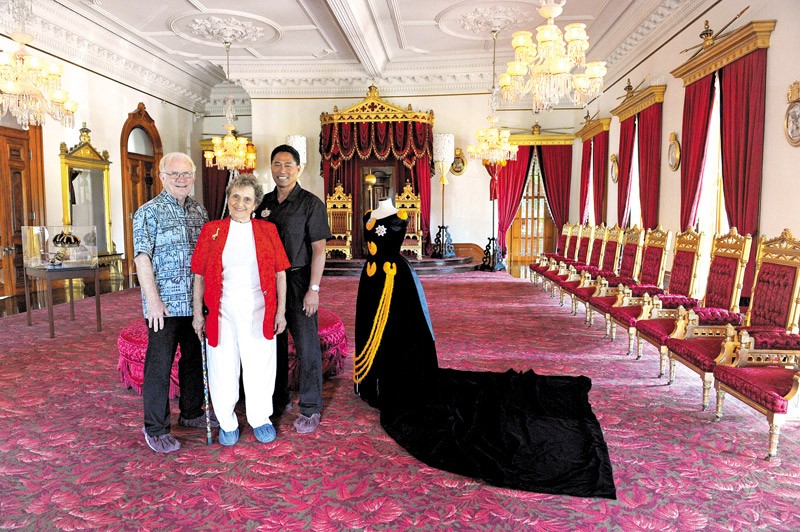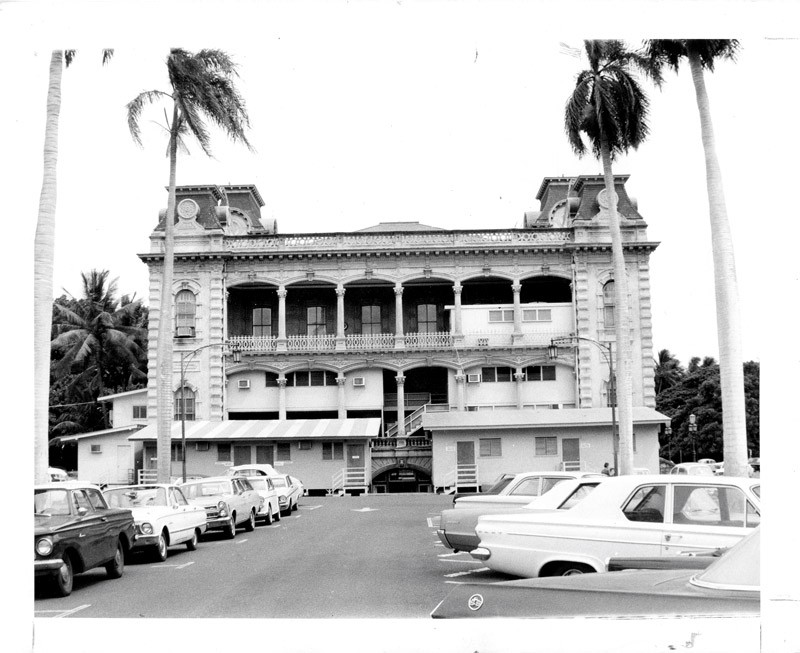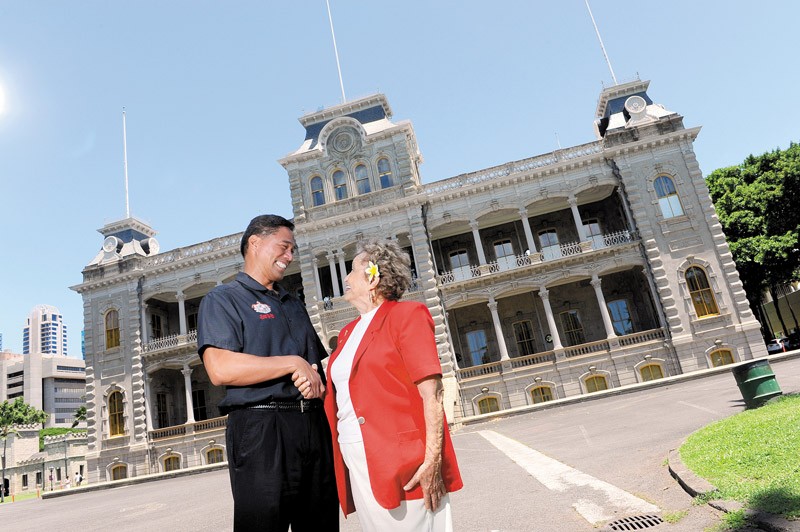Taking Back The Palace

The Friends of ‘Iolani Palace board president Robbie Alm (left), founding member Beadie Dawson and executive director Kippen de Alba Chu stand in the restored throne room, next to a replica of one of Queen Kapi‘olani’s famous gowns
It was practically a lifetime ago that the ladies of Junior League of Honolulu sat down and took an important vote on their group’s next project: the restoration of the dilapidated ‘Iolani Palace … or establishing a children’s petting zoo.
The palace was a termite-infested mess that housed the state Legislature. Its royal furnishings were largely gone, and little makeshift “offices” for lawmakers dotted the halls and grounds. Meetings were conducted in the former throne room, where portraits of U.S. presidents loomed over where King Kalakaua and Queen Lili‘uokalani once held court.
“The state was building this big Capitol building next door, and there was a lot of fear in the community … that the palace would be torn down,” explains The Friends of ‘Iolani Palace board president Robbie Alm. “It was ugly, with all the plywood and air-conditioning units sticking out.
“The place was in bad shape.”
But the women picked the palace — and persisted in their herculean task against every obstacle. And 50 years later, The Friends of ‘Iolani Palace celebrate their success with a special gala poi supper (see sidebar on Page 32) and soldier on, for even as the building has risen from the ashes, their work still is not done.
It was Beadie Dawson who originally proposed to the Junior League’s project finding committee in 1965 that they work to restore the palace. Her committee chairwoman Alice Guild (“an absolute warrior,” Dawson affirms) brushed aside doubts and got the ball rolling.
“There were all the naysayers saying, oh, you can’t do that, you can’t do that, it’s too big, it’s this, it’s that, it’s too big. And (Alice) just said no, we’re going to do it,” Dawson remembers.
Of course, there was one small hurdle in the way: Nobody in the Junior League had any idea exactly how to go about pulling off this restoration thing.
“None of us are historic preservationists, none of us know anything about architecture, none of us know anything about restoring a building,” Dawson muses. “We were just good-hearted people and we wanted to do this project, but we had no skills, no background, no expertise.”
So they reached out to two key people.
The first was historian and architect Charles E. Peterson, who gave them guidelines — form a government group to run the palace, form an independent Friends organization to oversee that group, and research everything from top to bottom.
“He said, tell the world what we’re doing,” Dawson recalls. “Don’t create a report and give it to some little organization, it’ll go on a shelf and stay there. You tell the world that you are doing this project.”
The other was Lydia Lili‘uokalani Kawananakoa Morris, daughter of the late heir apparent Prince David Kawananakoa. Morris was, at the time, working with Gov. John Burns and Mayor Neal Blaisdell on a Honolulu beautification committee, but she pledged her support to the palace project and was instrumental in bringing government support, as well as public and private funding, to the table.
And so, in 1966, The Friends of ‘Iolani Palace was born, founded and led by Morris until her death three years later.
Burns decided in 1967 that he “didn’t actually trust any government agency to run the palace,” according to Alm, and insisted the property be kept under the watchful eye of its original defenders.
Fifty years on, the Friends have transformed the former royal residence.
The ladies of the Junior League assembled two “shoeboxes” packed full of research when they first started the project.
“We researched every archive, every map, every correspondence, every picture, every book — everything that we could find on the original palace,” Dawson says.
Using that database, the women started scouring the globe to find the palace’s original furnishings.
After the overthrow in 1893, the revolutionaries inventoried ‘Iolani Palace’s contents. Some things were returned to the royal family, some were given away to European museums and much else was sold at auction to private collectors.
Volunteers visited museums and made personal pleas to have items returned. They went to auctions clandestinely to bid. They made appeals to those known to own a piece of palace history.
“Everybody, every single one of us, we were fanning out into the community to get things — either objects brought back to the palace or money to be brought back in again,” Dawson notes.
“It’s one on one that can go out and talk to people, and from there they talk to somebody else who is a family who has something, and we find out about it.
“It’s like a network of information.”
And bit by bit, from scraps of carpet woven into new rugs for the throne room to Kalakaua’s old silverware, ‘Iolani Palace has returned.
Their methods haven’t changed much in 50 years, says palace executive director Kippen de Alba Chu. The shoeboxes mostly have been digitized and now he sends emails, but it’s still the one-on-one interaction that rules the day.
He recently facilitated a donation from a man whose family owned one of Kalakaua’s presentation swords. An email exchange about Kingdom-era guns got the men talking about other things.
“I mentioned it was the 50th anniversary of our organization, and he mentioned his mom was one of the former presidents of the Junior League and had helped with the restoration project,” de Alba Chu says. “Because of that, he all of a sudden got very interested in our organization.”
Ultimately, that man and his siblings decided to pull the sword out of a previously scheduled auction, and instead donate it to ‘Iolani Palace in their parents’ name.
A few things, though, have changed with the decades.
“We’re working on the final restoration phase of the palace,” de Alba Chu says, noting that it soon will open its gallery basements to the public, with more interactive and technologically advanced displays than the period-accurate rooms upstairs, including themed exhibits that focus on royal jewels, kitchens and more.
One of his challenges, he says, is reminding people of the palace’s role in the world of today.
“Why should they come to the palace?” he asks. “It’s history, it passed. But the relevancy of the palace is that the decisions that were made by the monarchy in the late 1800s resonate today.”
The Friends of ‘Iolani Palace aren’t too worried about being forgotten. The site speaks for itself, after all.
“The palace has its own voice by its mere presence,” Dawson declares. “No matter how removed people become from their beginnings, (places like this) speak to you, and I think that the palace will always speak to people.”
The palace’s emphasis on school tours is paramount in reminding newer generations — to whom Hawaii’s royal past are simply stories of a bygone age — what makes their state unlike any of the other 49. Its highly trained docents lead thousands of visitors through each year.
“You can read about it, but coming into the palace with a trained docent is an experience in itself,” Dawson says.
Dawson also hopes that the behind-the-scenes story of ‘Iolani Palace — to be highlighted at the gala supper — can inspire others to try for the impossible.
“If the dedication is there and the will is there, you can do these things. You can take on a task that is so monumental that everybody is standing by and saying you can’t possibly do that. You can do it with everybody working together.”
There are still items missing from the palace, still work to be done before the restoration can call itself complete. But one person at a time, one meeting at a time, one email at a time, it will go on, as it has for half a century.
For more information, visit iolanipalace.org or call 522-0822.
* * *
The Friends of ‘Iolani Palace 50th Anniversary Gala Poi Supper Fundraiser
Fifty years is something to celebrate for The Friends of ‘Iolani Palace from 5:30 to 10 p.m. Sept. 24 on the palace grounds.
In addition to Hawaiian food, special guided tours of the facility, a sneak peek at the basement galleries and performances from Ku‘uipo Kumukahi, Kawika Kahiapo, Palani Vaughn and Amy Hanaiali‘i, the group specifically wants to shed light on its original founders.
“Back in the those days, a lot of the women were referred to by their husband’s names. When you look at the records, it’s Mrs. Robert Guild, not Alice, as we know her,” says Friends board president Robbie Alm, who also notes that the group has made it a priority to spotlight these women.
“It’s fascinating to have all these names resurface.”
Admission is $150 per person. To purchase tickets or for more information, contact Pomai Toledo at 522-0827 or members@iolanipalace.org.








